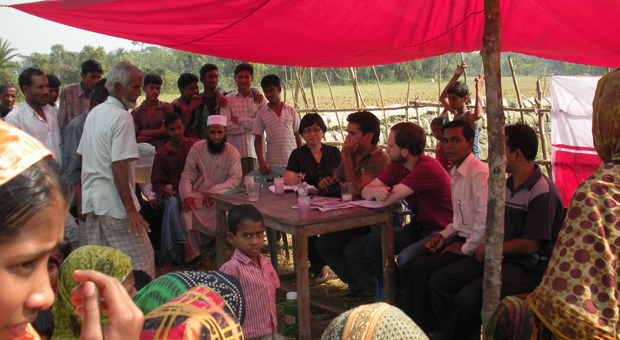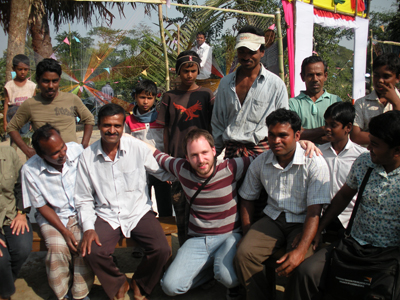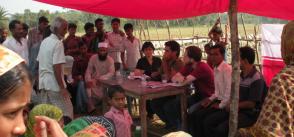
ICT is changing agriculture: interview with Simone Sala
Simone Sala likes describing himself as "a traveller across Global Development, Agriculture, Environment, and Security via Technology".
Simone is a researcher and practitioner working on the application of Information and Communication Technologies for sustainable development (ICT4D), with a focus on agriculture and natural resources management in developing and emerging regions. As a practitioner Simone supported UN FAO’s Communication for Sustainable Development Initiative and various NGOs in rural development projects, and assisted the Italian Ministry of Foreign Affairs in the application of ICT to promote improved water management in the Middle East. As a researcher Simone currently collaborates with the Columbia University Center for International Conflict Resolution (CICR), the MIT-IBM Network Science Research Center, and the Department of Agricultural and Environmental Sciences - Production, Landscape, Agroenergy (DISAA) of the University of Milan.
We discovered his activities, travels, and studies through his twitter profile, which soon revealed to be an important source of information, comments, and data on the application of new technologies to agriculture and climate issues. The interview with Simone revolves around the role of ICT and the changes it brought and will continue to bring about to agriculture production and consequently to food security.
1) In your opinion, to what extent and in which ways can ICT improve access to high quality affordable food?
Nowadays is clear that providing high-quality affordable food is not only a matter of enhancing agricultural production, an area where ICT is definitely helping already worldwide, but also of improving food distribution and utilization in both the Global North and South.
To do so, ICT can be a powerful driver of transparency across existing producer-consumer networks. Particularly, ICT have been instrumental in improving logistics’ efficiency (thus reducing overall costs) and effectiveness (thus minimizing post-harvest losses) across food supply chain. This has resulted in reduced distribution costs as well as improved quality of food products to the benefit of consumers.
Particularly, ICT have been instrumental in improving logistics’ efficiency (thus reducing overall costs) and effectiveness (thus minimizing post-harvest losses) across food supply chain. This has resulted in reduced distribution costs as well as improved quality of food products to the benefit of consumers.
Within this framework, ICT also has a great potential in reducing food waste, which now accounts for up to 30% of the overall food produced in the Western World, through the implementation of smarter supply chains. A nice example of such potential is represented by IBM and University of Bari’s project to support local fishing industry via cloud computing.
The role of ICT in strengthening food safety is also growing – thanks to enhanced traceability systems as well as to the expanded use of advanced tools and technologies (such as spectrophotometers) to monitor the quality of food before the distribution phase, and eventually ensuring that consumers can receive food products respecting quality standards.
Finally, ICT can help expanding access to food - especially among poorest communities.
Thanks to remote sensing and mapping technologies it has become easier to identify food insecurity hotspots or bottlenecks in food access, and plan ad hoc countermeasures. Needless to say, technology is not enough: the case of India’s computerization of its huge Public distribution system (PDS) is a very interesting example of limits and opportunities offered by ICT applied to expand food access.
2) In which ways, does ICT change the production, distribution and consumption of agricultural products?
ICT is changing agricultural production at different levels, both before and during actual crop production. First of all, ICT are expanding collection and sharing of all data and information that are key to plan an agricultural production strategy. These include (but are not limited to) information needed to select the most appropriate crops given farmers’ assets, plan and manage its related cropping calendar, and access to credit and inputs. Moreover, ICT is increasing effectiveness of all management operations specifically linked to agricultural production, such as applications in input and water management.
Sensors are definitely playing a huge role in improving the monitoring of agricultural production via up-to-date data and information. Now key decision-making processes of agricultural production are information-enabled: meteorological forecasts, crop prices, and spreading patterns of pest and diseases do concur together in making agricultural production more dynamically responsive to local and current variability. An interesting case study is that of the Jamaica Traceability System, an information system set up by the Jamaican government to map location of pepper farms and monitor the diffusion of pests preventing local pepper to be exported in North America and Europe.
With regards to the distribution of agricultural products, ICT is surely changing supply-chain networks by making the producer/consumer relationship more interactive.
 This is already true for some added-value products (e.g. cash crops like coffee), where ICT is supporting traceability of products “from farm to fork” thanks to the introduction of bar codes, RFID, and other relatively low-cost information identifiers. It is very likely that such approach will be extended to most agricultural products: not only food then, but also feed and fibers.
This is already true for some added-value products (e.g. cash crops like coffee), where ICT is supporting traceability of products “from farm to fork” thanks to the introduction of bar codes, RFID, and other relatively low-cost information identifiers. It is very likely that such approach will be extended to most agricultural products: not only food then, but also feed and fibers.
ICT is also transforming the way agricultural products are consumed by adding value to agricultural products in a way that was not possible a few years back. The social web is pushing deep changes in consumption patterns, expanding marketing of agricultural products as well as making consumers more informed and raising their awareness on sustainability issues.
Finally, recent data visualization technologies are helping to keep track of the consumption of resources needed for agricultural production. In such sense the Land Matrix web portal is a great example of the way ICT can provide up-to-date data and information on investments in land worldwide.
3) Which is the role of the private sector in ICT for agriculture?
On one hand ICT has been instrument to make efficiency grow in agriculture at both production and distribution stage, just like happened in other sectors. The private sector has largely been the early adopter of such tools and the driver of the related transformations. Private companies in the ICT sector have been playing in the agricultural sector as technology providers, e.g. including telecommunications systems, software applications, monitoring hardware. Beside that, I also see ICT as a possible enabler of innovative partnerships between private sector meaning private agribusinesses and other small businesses that are active in the sector (e.g. producers, transformation companies, distribution agents).
It is particularly interesting to look at what is happening in emerging and developing regions, where there are already ICT applications innovatively linking agricultural stakeholders that are scaling up from the informal to the broader level – i.e. from sporadic employment by agricultural stakeholders to institutional programs and policies. The easiest and simplest example of such trend is the unwritten, though pivotal partnership, established between telecommunication operators and smallholder farmers across the developing World.
ICT made reachable those who were not, even including farmers that don’t have the money to make calls but became suddenly visible to buyers by owning a mobile phone with an active subscription.
Very interestingly new communication codes spread in some regions, such as those linking specific meanings to the number of rings made to the recipient’s mobile phone (a kind of Morse Code 2.0). In the near future, Telecommunication companies will probably expand their value-added (mobile) services to both agricultural producers and operators of the supply chain.
Another area where I see a tremendous opportunity for innovation is the application of datafication practices in agriculture.
It’s no surprise that Monsanto recently acquired (for a record 1-billion USD) Climate Corporation, one of the first companies envisioning the provision of hyper-local climate data to farmers in the United States. Despite understandable farmers’ reluctance in sharing their data with private companies, it is very likely that fruitful partnerships will develop along those lines - with farmers becoming both consumers and providers of data and information, especially in data-scarse regions of the world.
Finally, a rich ecosystem of mobile applications targeting the agricultural sector has been flourishing – and quite interestingly a number of these applications just come from developing World. Some of these applications offer ad hoc mobile decision supporting systems, such as iCow does in Kenya with livestock farmers. Similarly, private companies also leveraged ICT to create broader platforms (such as Reuters Market Light in India and Esoko in Ghana) to offer farmers customized information to improve their professional activity.
[Photos courtesy of Simone Sala]








